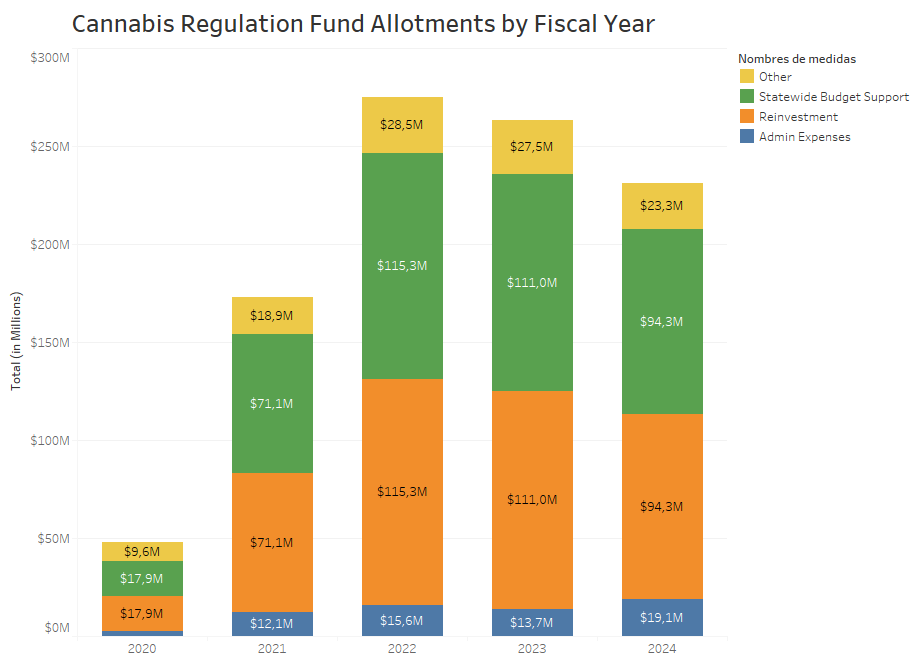Zinger Key Points
- Illinois reports $144.5M in April cannabis sales, directing tax revenue to community programs and the 'rainy day' fund
- State’s unique tax strategy varies by THC content, with rates up to 25%, aligning with administrative costs and local levies.
- Markets are swinging wildly, but for Matt Maley, it's just another opportunity to trade. His clear, simple trade alerts have helped members lock in gains as high as 100% and 450%. Now, you can get his next trade signal—completely free.
In May 2024, the Illinois Department of Financial and Professional Regulation noted a significant increase in adult-use cannabis sales, amounting to $144.5 million – a 9.5% rise from April 2023’s $132 million. However, sales experienced a slight decline from March’s $148.9 million by 2.93%.
Despite these fluctuations, the fiscal year 2024 has already seen the state amassing over $230 million in cannabis-related taxes. The question now is: How is Illinois using these funds?
Strategic Allocation Of Cannabis Taxes: Community Reinvestment
As ordered by the state’s cannabis law, tax revenue from cannabis is being reinvested through social equity programs, the most relevant one is known as R3: Restore, Reinvest, and Renew. According to the latest statistics, this initiative has channeled $94.3 million toward communities in Illinois adversely affected by violence, excessive incarceration and economic disinvestment.
In what is normally a measure of fiscal prudence undertaken by many States, Illinois has allocated the equivalent amount of R3 money to the Budget Stabilization Fund, commonly referred to as the rainy day fund. Each of these destinations explains 40% of the tax budget coming from the cannabis industry.
The management of the cannabis market involves significant administrative costs, accounting for 15% of total expenditures or $19,1 million in 2024. This funding also supports non-directly related state agencies, like the Illinois State Police and the Department of Agriculture, that naturally play a role in the cannabis environment.

A Closer Look at Illinois' Cannabis Tax Structure
Illinois employs a distinctive tax strategy at both wholesale and retail levels. Wholesale transactions involving cannabis products from cultivation centers or craft grows incur a 7% tax. Retail sales, however, are taxed based on the THC potency of the product. Cannabis flowers or products with less than 35% THC are taxed at 10%, while edible and other infused products are taxed at 20%. Products with a THC concentration over 35% face the highest tax rate at 25%. This tiered approach is designed to reflect the varied nature of cannabis products and their uses. Taxation results depend, as an ultimate factor, on general consumer preferences and budget constraints.
Future Challenges From Neighbors
This tax model contrasts sharply with neighboring Missouri, which imposes a lower tax rate on its cannabis industry. Such discrepancies could potentially lead to issues if cross-border cannabis transportation becomes legal, positioning Illinois in a unique spot in regional cannabis markets. Furthermore, Illinois also applies its standard 6.25% sales tax, with local taxes potentially adding up to 3.5%.
Seeking to re-organize the industry, lawmakers are pushing some changes in legislation such as measures to restrict sales of synthetic hemp-derived products to state-licensed cannabis. As Illinois continues to navigate the complex interplay of market growth, taxation and legislative challenges, the effectiveness of its tax structure and community reinvestment strategies remain a focal point in shaping the future of its cannabis industry.
© 2025 Benzinga.com. Benzinga does not provide investment advice. All rights reserved.
Trade confidently with insights and alerts from analyst ratings, free reports and breaking news that affects the stocks you care about.
Cannabis is evolving – don’t get left behind!
Curious about what’s next for the industry and how to leverage California’s unique market?
Join top executives, policymakers, and investors at the Benzinga Cannabis Market Spotlight in Anaheim, CA, at the House of Blues on November 12. Dive deep into the latest strategies, investment trends, and brand insights that are shaping the future of cannabis!
Get your tickets now to secure your spot and avoid last-minute price hikes.